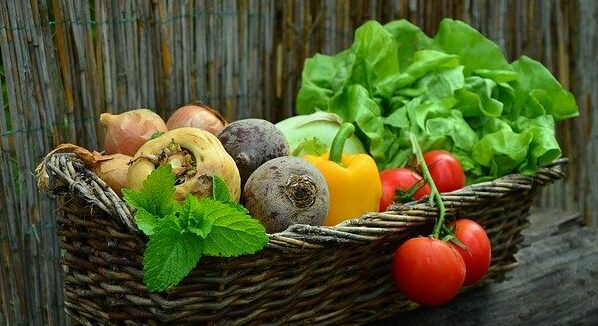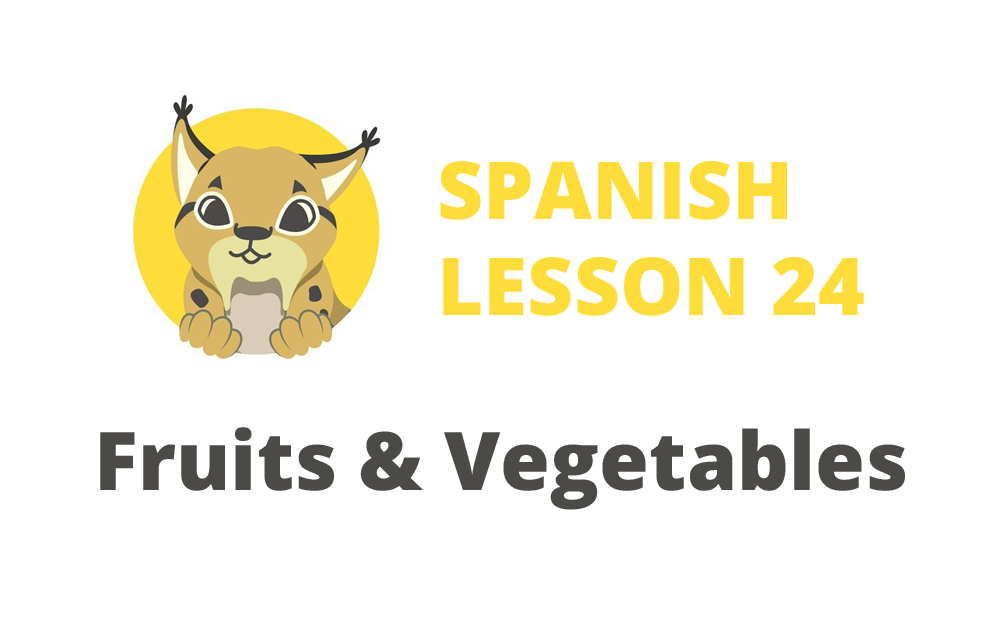This is the twenty-fourth lesson in our beginner level Spanish course and we will look at Fruits and Vegetables in Spanish.
We will learn useful new vocabulary related to Fruits and Vegetables in Spanish and practice using it with the regular verbs Comer (To eat), Comprar (To buy), and Cocinar (To cook) that we learned in Lesson 20: Present Tense with Regular Verbs and Lesson 21: More Regular Verbs in Present Tense.
We will also use the information about Telling the Time in Spanish that we learned in Lesson 22: The Time and Lesson 23: Present Tense with Time.
If you want to learn more Spanish, you can easily do it with our Free Spanish Online Course.
Vegetables in Spanish (Las Verduras)

- El repollo/La col: cabbage
- La zanahoria: carrot
- La coliflor: cauliflower
- El pepino: cucumber
- El ajo: garlic
- La lechuga: lettuce
- Los champiñones: mushrooms
- El pimiento: pepper
- El brócoli: broccoli
- La cebolla: onion
- La papa/La patata: potato
- El maíz: sweet corn
- El tomate: tomato
- Las arvejas/Los guisantes: peas
- La berenjena: aubergine, eggplant
- El puerro: leek
- La espinaca: spinach
Fruits in Spanish (Las Frutas)

- La manzana: apple
- La uva: grape
- La sandía: watermelon
- El plátano: banana
- La fresa: strawberry
- La piña: pineapple
- El melón: melon
- La naranja: orange
- El melocotón: peach
- La pera: pear
- El limón: lemon
- El kiwi: kiwi
- La lima: lime
- El mango: mango
- La ciruela: plum
- La frambuesa: raspberry
- La grosella: currant
- La zarzamora: blackberry
- El arándano: blueberry
- El maracuyá: passion fruit
First, let’s learn some new vocabulary of Fruits and Vegetables in Spanish.
You will find a lot of vocabulary listed above.
Please don’t feel that you have to memorize everything right away. Aim to learn five or six new words a day and try to be consistent with your studies.
Vocabulary tends to be the most challenging area of learning a language because it is so vast. Be patient and take it steady.
And don’t forget to carry a dictionary or dictionary app with you at all times to look up words you can’t remember or haven’t learned yet.
Next, let’s practice using this new vocabulary with the regular verbs Comer (To eat), Comprar (To buy), and Cocinar (To cook).
Here are the conjugation rules for regular verbs in Present Tense:
| Yo Tú Él/Ella Nosotros/as Vosotros/as Ellos/Ellas |
-o -as/-es -a/-e -amos/-emos/-imos -áis/-éis/-ís -an/-en |
Practice the dialog with fruits and vegetables in Spanish
- Comes frutas y verduras? – Do you eat fruit and vegetables?
- Sí, como muchas frutas y verduras – Yes, I eat a lot of fruit and vegetables.
- ¿Qué frutas comes? – What fruits do you eat?
- Como una naranja todos los días por la mañana – I eat an orange every day in the morning
- Como una manzana a las once de la mañana – I eat an apple at eleven o’clock in the morning
- Como un plátano por la tarde – I eat a banana in the afternoon.
- Y a las seis o siete de la tarde como fresas o frambuesas con yogur – And at six or seven o’clock in the afternoon I eat strawberries or raspberries with yoghurt
- ¿Dónde compras la fruta? – Where do you buy the fruit?
- Compro la fruta en el supermercado – I buy the fruit in the supermarket
- ¿Qué verduras comes? – What vegetables do you eat?
- Como todas las verduras – I eat all kinds of vegetables
- Siempre cocino con ajo y cebolla – I always cook with garlic and onion
- Comemos muchas zanahorias, espinacas, coles, brócoli y maíz – We eat a lot of carrots, spinach, cabbage, broccoli, and sweetcorn.
- ¿A qué hora coméis? – At what time do you have lunch?
- Comemos a las dos – We eat at two o’clock
Observe that the ending of the verbs Comer (To eat), Comprar (To buy), and Cocinar (To cook) are changed depending on the person doing the action.
For example, if the sentence is “I eat” then the verb Comer will be changed to Como and if the sentence is “We buy” then the verb Comprar will be changed to Compramos.
Keep practicing by creating your own sentences using Spanish regular verbs with The Time and the conjugation rules we have learned for Present Tense.
